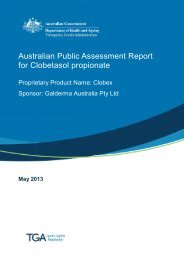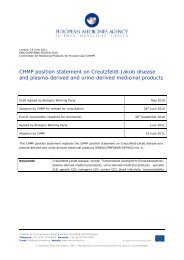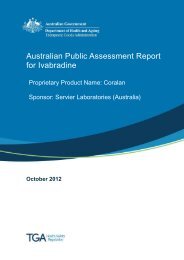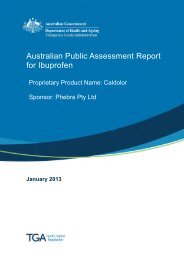AusPAR: Cabazitaxel - Therapeutic Goods Administration
AusPAR: Cabazitaxel - Therapeutic Goods Administration
AusPAR: Cabazitaxel - Therapeutic Goods Administration
You also want an ePaper? Increase the reach of your titles
YUMPU automatically turns print PDFs into web optimized ePapers that Google loves.
<strong>AusPAR</strong> Jevtana <strong>Cabazitaxel</strong> Sanofi-Aventis Australia Pty Ltd PM-2010-02565-3-4<br />
Final 9 February 2012<br />
<strong>Therapeutic</strong> <strong>Goods</strong> <strong>Administration</strong><br />
cabazitaxel achievable in these studies, limited information or conclusions can be drawn<br />
from the negative findings. 11<br />
Supplementary safety pharmacology studies included investigation of effects on the renal<br />
system (urine parameters and electrolyte excretion in saline loaded rats) and the<br />
gastrointestinal system (in vivo transit time and in vitro response to ileal spasmogens),<br />
with the in vivo studies at doses up to 5 mg/kg IV in rats and in vitro concentrations up to<br />
10 µM. In all these studies, cabazitaxel showed no (or minimal) effects, except for a<br />
significant reduction in urinary potassium excretion in the study of renal function. No<br />
specific findings on the renal system were observed in rats or in dogs in other toxicity<br />
studies. Histological changes to the intestines following a single IV dose of 5 or 10 mg/kg<br />
to rats did not translate into a functional change in terms of gastrointestinal transit after<br />
5 mg/kg.<br />
Overall, the safety pharmacology studies indicate that cabazitaxel had a similar profile to<br />
other taxanes on the cardiovascular, respiratory, renal and gastrointestinal systems. The<br />
microscopic findings seen in the CNS of treated rats is not a common feature of the taxane<br />
class.<br />
Pharmacokinetics<br />
Absorption<br />
Clearance was high in all species investigated. Volume of distribution at steady state<br />
appeared to be large (greater than body water) in all these species (although estimates in<br />
mice and dogs varied considerably), consistent with wide tissue distribution of<br />
cabazitaxel/metabolites to tissues. In humans, terminal half-life (123 hours [h]) was<br />
longer than in the laboratory animal species (0.35-26 h), although estimates in mice and<br />
dogs were variable.<br />
There was no clear evidence of a sex difference in the absorption of cabazitaxel in either<br />
rats or dogs (only females were investigated in mice), nor in the distribution kinetics in<br />
rats. There was little evidence of accumulation following any of the repeated dosing<br />
schedules investigated in mice, rats or dogs. Exposure to cabazitaxel increased in an<br />
approximately dose proportional manner in mice but generally in a supra dose<br />
proportional manner in rats and dogs, possibly due to saturation of metabolic pathways.<br />
The proposed Product Information (PI) notes that there was no major deviation to dose<br />
proportionality in patients with advanced solid tumours over the relatively narrow dose<br />
range of 10 to 30 mg/m 2.<br />
The cabazitaxel metabolites, docetaxel and RPR123142 were only detectable at high doses<br />
(10 mg/kg IV, but not 1 mg/kg IV) in mice and rats. Docetaxel was not detectable in dogs<br />
but only low doses were achievable in this species. These findings are consistent with<br />
cabazitaxel being the main circulating drug related compound.<br />
Distribution<br />
In vitro protein binding was high in all species. At concentrations up to 10 µg/mL, protein<br />
binding was >98% in mice, 96−97% in dogs, 95−97% in rats, 85−93% in rabbits and 89-<br />
92% in humans , as determined by equilibrium dialysis using [14C]cabazitaxel and, with<br />
the exception of mice, there was little evidence of saturation. Some concentration<br />
dependent changes in protein binding were seen with mouse plasma, although protein<br />
11 Masini E, Planchenault J, Pezziardi F, Gautier P, Gagnol JP. Histamine releasing properties of<br />
polysorbate 80 in vitro and in vivo: correlation with its hypotensive action in the dog. Agents and<br />
Actions 1985; 16: 470-477.<br />
Page 12 of 75
















